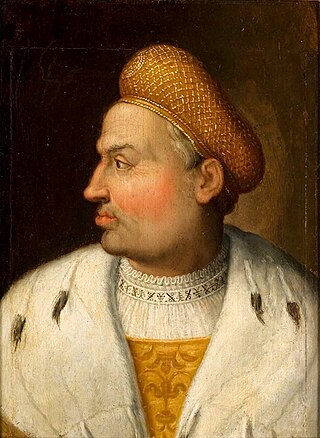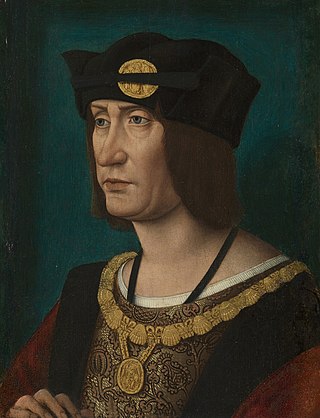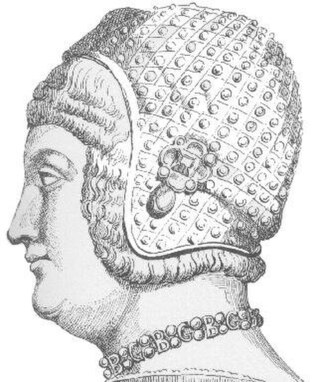Related Research Articles

The House of Sforza was a ruling family of Renaissance Italy, based in Milan. They acquired the Duchy of Milan following the extinction of the Visconti family in the mid-15th century, Sforza rule ending in Milan with the death of the last member of the family's main branch in 1535.

The War of the Polish Succession was a major European conflict sparked by a civil war in the Polish–Lithuanian Commonwealth over the succession to Augustus II the Strong, which the other European powers widened in pursuit of their own national interests. France and Spain, the two Bourbon powers, tested the power of the Austrian Habsburgs in Western Europe, as did the Kingdom of Prussia, whilst Saxony and Russia mobilized to support the eventual victor. The fighting in Poland–Lithuania resulted in the accession of Augustus III, who in addition to Russia and Saxony, was politically supported by the Habsburgs.

Sigismund of Luxembourg was Holy Roman Emperor from 1433 until his death in 1437. He was elected King of Germany in 1410, and was also King of Bohemia from 1419, as well as prince-elector of Brandenburg. As the husband of Mary, Queen of Hungary, he was also King of Hungary and Croatia from 1387. He was the last male member of the House of Luxembourg.

Sigismund II Augustus was King of Poland and Grand Duke of Lithuania, the son of Sigismund I the Old, whom Sigismund II succeeded in 1548. He was the first ruler of the Polish–Lithuanian Commonwealth and the last male monarch from the Jagiellonian dynasty.

Sigismund I the Old was King of Poland and Grand Duke of Lithuania from 1506 until his death in 1548. Sigismund I was a member of the Jagiellonian dynasty, the son of Casimir IV and younger brother of Kings John I Albert and Alexander I Jagiellon. He was nicknamed "the Old" in later historiography to distinguish him from his son and successor, Sigismund II Augustus. Before ascending to the Polish and Lithuanian thrones, he was Duke of Głogów from 1499, Duke of Opava from 1501, and governor of Silesia from 1504 on behalf of his brother, King Vladislaus II of Bohemia and Hungary.

Francis I was King of France from 1515 until his death in 1547. He was the son of Charles, Count of Angoulême, and Louise of Savoy. He succeeded his first cousin once removed and father-in-law Louis XII, who died without a legitimate son.

Louis XII was King of France from 1498 to 1515 and King of Naples from 1501 to 1504. The son of Charles, Duke of Orléans, and Marie of Cleves, he succeeded his second cousin once removed and brother-in-law, Charles VIII, who died childless in 1498.

Bona Sforza d'Aragona was Queen of Poland and Grand Duchess of Lithuania as the second wife of Sigismund the Old, and Duchess of Bari and Rossano by her own right. She was a surviving member of the powerful House of Sforza, which had ruled the Duchy of Milan since 1447.

Catherine Jagiellon was a Polish - Lithuanian Commonwealth princess and Queen of Sweden from 1569 as the wife of King John III. Catherine had significant influence over state affairs during the reign of her spouse. She negotiated with the pope to introduce Counter-Reformation in Sweden. She was the mother of Sigismund, King of Poland (1587-1632) and Sweden (1592-1599).

Isabella Jagiellon was the queen consort of Hungary. She was the oldest child of Sigismund I the Old, King of Poland, and his Italian wife Bona Sforza.

Christina of Denmark was a Danish princess, the younger surviving daughter of King Christian II of Denmark and Norway and Isabella of Austria. By her two marriages, she became Duchess of Milan, then Duchess of Lorraine. She served as the regent of Lorraine from 1545 to 1552 during the minority of her son. She was also a claimant to the thrones of Denmark, Norway and Sweden in 1561–1590 and was sovereign Lady of Tortona in 1578–1584.

Anna Jagiellon was Queen of Poland and Grand Duchess of Lithuania from 1575 to 1587.

Isabella of Aragon, also known as Isabella of Naples, was by marriage Duchess of Milan and suo jure Duchess of Bari.

The Italian War of 1521–1526, sometimes known as the Four Years' War, was a part of the Italian Wars. The war pitted Francis I of France and the Republic of Venice against the Holy Roman Emperor Charles V, Henry VIII of England, and the Papal States. It arose from animosity over the election of Charles as Emperor in 1519–1520 and from Pope Leo X's need to ally with Charles against Martin Luther.

The Wars in Lombardy were a series of conflicts between the Republic of Venice and the Duchy of Milan and their respective allies, fought in four campaigns in a struggle for hegemony in Northern Italy that ravaged the economy of Lombardy. They lasted from 1423 until the signing of the Treaty of Lodi in 1454. During their course, the political structure of Italy was transformed: out of a competitive congeries of communes and city-states emerged the five major Italian territorial powers that would make up the map of Italy for the remainder of the 15th century and the beginning of the Italian Wars at the turn of the 16th century. They were Venice, Milan, Florence, the Papal States and Naples. Important cultural centers of Tuscany and Northern Italy—Siena, Pisa, Urbino, Mantua, Ferrara—became politically marginalized.

Bona of Savoy, Duchess of Milan was Duchess of Milan as the second spouse of Galeazzo Maria Sforza, Duke of Milan. She served as regent of Milan during the minority of her son 1476–1481.

The Franco-Ottoman alliance, also known as the Franco-Turkish alliance, was an alliance established in 1536 between Francis I, King of France and Suleiman I of the Ottoman Empire. The strategic and sometimes tactical alliance was one of the longest-lasting and most important foreign alliances of France, and was particularly influential during the Italian Wars. The Franco-Ottoman military alliance reached its peak with the Invasion of Corsica of 1553 during the reign of Henry II of France.

Antonio Rincon, also Antoine de Rincon, was a Spanish-born diplomat in the service of France. An influential envoy from the King of France to Sultan Suleiman I of the Ottoman Empire, he made various missions to Constantinople between 1530 and 1541. While an effective diplomat, Rincon's enemies considered him a renegade and some later observers would criticize him for promoting Machiavellian policies.

A Franco-Hungarian alliance was formed in October 1528 between King Francis I of France and King John Zápolya of Hungary.

The Jagiellonian or Jagellonian dynasty, otherwise the Jagiellon dynasty, the House of Jagiellon, or simply the Jagiellons, was the name assumed by a cadet branch of the Lithuanian ducal dynasty of Gediminids upon reception by Jogaila, the Grand Duke of Lithuania, of baptism as Władysław in 1386, which paved the way to his ensuing marriage to the Queen Regnant Jadwiga of Poland, resulting in his ascension to the Crown of the Kingdom of Poland as Władysław II Jagiełło, and the effective promotion of his branch to a royal dynasty. The Jagiellons reigned in several European countries between the 14th and 16th centuries. Members of the dynasty were Kings of Poland (1386–1572), Grand Dukes of Lithuania, Kings of Hungary, and Kings of Bohemia and imperial electors (1471–1526).